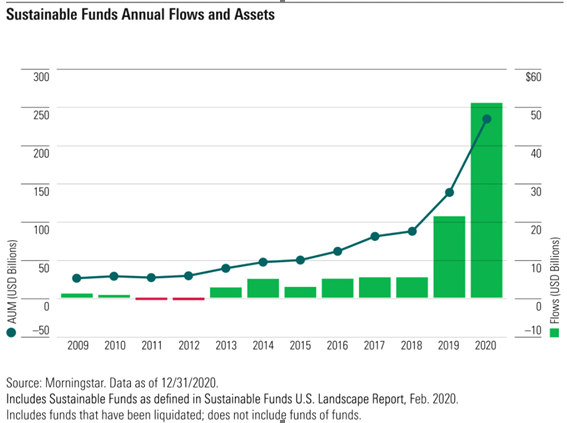Many have heard the terms ‘socially responsible investing’ or ‘impact investing’ before, but ‘environmental, social, and corporate governance (ESG) investing’ may be new to some. These three terms are often used interchangeably within the industry, but ESG investing has become the most common in recent years. It captures the overall landscape and is a more inclusive and analytical approach.
For most, investing in an ESG portfolio is a way to align their personal views with their investments. At Cardinal Point, we have ESG investment options available both in the US and Canada. We know that this is important to some of our clients, and we strive to provide robust investment options for those that are interested.
While the ESG landscape is moving out of a niche and into the mainstream, it is still in the early innings. ESG investing has been steadily growing in assets over the past few years and took a major leap forward in 2020. As shown in the below graph, assets under management in open-end funds and ETFs available to US investors reached $236.4 billion at the end of 2020. In Canada, ESG assets under management have grown 48% over the last two years. This growth is not specific to the US or Canada; on a global level, ESG assets under management increased by 29% in the fourth quarter of 2020 alone.

ESG factors are often overlapping, and it can be difficult to classify any one issue within the environmental, social, or governance buckets. Additionally, there is not a comprehensive list of examples for each. Historically, the environmental factor has garnered the most attention, but all three factors play a key role in building a globally diversified ESG portfolio.
Environmental factors relate to the sustainability and conservation of our natural environment. Some key elements include climate change and carbon emissions, air and water pollution, biodiversity, deforestation, energy efficiency, and waste management.
Social factors relate to the consideration of people and relationships. Some key elements include customer satisfaction, data protection, gender and diversity, community relations, human rights, and labor standards.
Governance factors relate to the standards for running a company. Some key elements include board composition, bribery and corruption, executive compensation, lobbying, and political contributions.
There are a variety of different methodologies used to analyze and implement ESG factors. Some include completely excluding companies in certain industries such as fossil fuel or tobacco. Others evaluate measurable metrics and utilize a ranking process that systematically assigns higher allocations to companies with high ratings and underweights companies with low ratings relative to their sector peers.
Implementing ESG analysis shifts the portfolio towards companies with higher ESG ratings with a goal of maintaining the overall risk and return characteristics of the underlying index. As with any investment strategy, there are risks to consider. Shifting the portfolio towards companies with higher ESG ratings may reduce diversification in some sectors, which could lead to a return that deviates from the underlying index. As ESG investing is an evolving segment of the market, there is ongoing research and debate as to how much of an impact this has.
Our Investment Committee continues to monitor this evolving segment of the market to provide options for interested clients to help them make the world a better place with their wealth. If you would like to discuss these ESG options in more detail, please reach out to your Private Wealth Manager and we can review together as it relates to your long-term goals and objectives.
Sources: CFA Institute, Morningstar, “2020 Canadian Responsible Investment Trends Report”, Responsible Investment Association, “Sustainable fund assets hit record $1.7 trln in 2020: Morningstar”, Simon Jessop and Elizabeth Howcroft, Reuters
All investments involve risk, including the loss of principal and cannot be guaranteed against loss by a bank, custodian, or any other financial institution.











